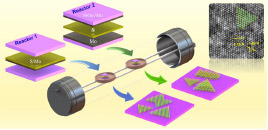Department of Physics and Astronomy: Publications and Other Research

Xia Hong Publications
Document Type
Article
Date of this Version
2015
Citation
Appl. Phys. Lett. 107, 152906
Abstract
We report the effect of epitaxial strain on the magnitude and retention of the ferroelectric field effect in high quality PbZr0.3Ti0.7O3 (PZT)/3.8-4.3 nm Sm0.5Nd0.5NiO3 (SNNO) heterostructures grown on (001) LaAlO3 (LAO) and SrTiO3 (STO) substrates. For SNNO on LAO, which exhibits a first-order metal-insulator transition (MIT), switching the polarization of PZT induces a 10 K shift in the transition temperature TMI, with a maximum resistance change between the on and off states of Δ𝑅/𝑅on ~75%. In sharp contrast, only up to 5% resistance change has been induced in SNNO on STO, where the MIT is second-order, with the modulation of TMI negligibly small. We also observe thermally activated retention of the off state resistance Roff in both systems, with the activation energy of 22 meV (28 meV) for devices on LAO (STO). The time dynamics and thermal response of the field effect instability points to phonon-assisted interfacial trapping of charged mobile defects, which are attributed to strain induced oxygen vacancies. At room temperature, Roff stabilizes at ~55% and ~19% of the initial switching levels for SNNO on LAO and STO, respectively, reflecting the significantly different oxygen vacancy densities in these two systems. Our results reveal the critical role of strain in engineering and modeling the complex oxide composite structures for nanoelectronic and spintronic applications.


Comments
Used by permission.